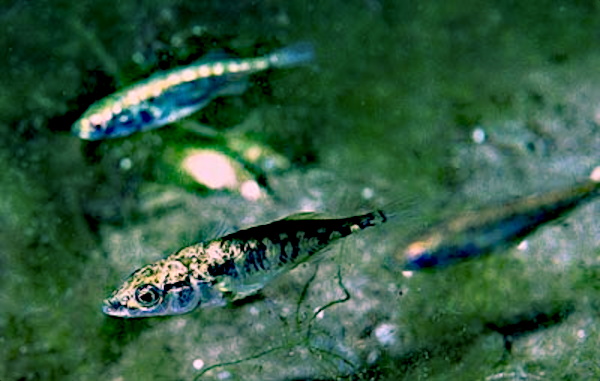 Evolution
Evolution
 Faith & Science
Faith & Science
 Life Sciences
Life Sciences
Loss of Function in Stickleback Fish = Loss of Another Argument for “Macroevolution” for Francis Collins
 In his book The Language of God, theistic evolutionist scientist Francis Collins contends that diversity within populations of stickleback fish demonstrates that there is no distinction between “macroevolution” and “microevolution.” According to Collins, “It is not hard to see how the difference between freshwater and saltwater sticklebacks could be extended to generate all kinds of fish. The distinction between macroevolution and microevolution is therefore seen to be rather arbitrary; larger changes that result in new species are a result of a succession of smaller incremental steps.” (p. 132) Aside from the fact that this provides another example refuting the Darwinist myth that ID proponents invented terms like “macroevolution” or “microevolution,” a closer look at the facts shows that Collins’ story sheds little light, if any, on “macroevolution,” unless one considers loss of function to constitute impressive “macroevolution.”
In his book The Language of God, theistic evolutionist scientist Francis Collins contends that diversity within populations of stickleback fish demonstrates that there is no distinction between “macroevolution” and “microevolution.” According to Collins, “It is not hard to see how the difference between freshwater and saltwater sticklebacks could be extended to generate all kinds of fish. The distinction between macroevolution and microevolution is therefore seen to be rather arbitrary; larger changes that result in new species are a result of a succession of smaller incremental steps.” (p. 132) Aside from the fact that this provides another example refuting the Darwinist myth that ID proponents invented terms like “macroevolution” or “microevolution,” a closer look at the facts shows that Collins’ story sheds little light, if any, on “macroevolution,” unless one considers loss of function to constitute impressive “macroevolution.”
There are two basic groups of sticklebacks: marine (saltwater) sticklebacks that have armor-plating, and freshwater sticklebacks with normal fish scales and little-to-no armor-plating. According to Collins, the presence of unique armor-plating in marine sticklebacks shows great variation within a group that is relatively low on the taxonomic hierarchy, allegedly demonstrating the possibility for large-scale evolution. Or perhaps better put, microevolutionary devolution…
A scientific study published a few months ago reports that the marine stickleback (the ones with the armor plates) came before freshwater sticklebacks (the ones without armor-plating), meaning that this is not an example of the evolution of a new function, but an example of loss-of-function, or what one might term devolution. As a Science Daily press release on the paper from this past September stated, this evolution entailed “[s]hedding some genetically induced excess baggage”:
Shedding some genetically induced excess baggage may have helped a tiny fish thrive in freshwater and outsize its marine ancestors. Measuring three to 10 centimetres long, stickleback fish originated in the ocean but began populating freshwater lakes and streams following the last ice age. Over the past 20,000 years — a relatively short time span in evolutionary terms — freshwater sticklebacks have lost their bony lateral plates, or “armour,” in these new environments. “Scientists have identified a mutant form of a gene, or allele, that prohibits the growth of armour,” says UBC Zoology PhD candidate Rowan Barrett. Found in fewer than one per cent of marine sticklebacks, this allele is very common in freshwater populations.
Alas, Collins’ example, which is intended to break down the distinction between macroevolution and microevolution, really only provides evidence that populations of organisms can lose unique and complex features when selection pressure is relaxed. This tells us nothing about how complex features like armor-plating evolved in the first place — it just shows something we already knew: that Darwinian evolution is great at losing functional genetic information. I’m sure that most biologists — either pro-ID or anti-ID — would consider finding that populations can lose certain complex features to be unsurprising.
The argument that this example of evolution is weak because it entails loss of function is also made by some leading evolutionary biologists. Hopi E. Hoekstra and Jerry Coyne’s review article, “The Locus of Evolution: Evo Devo and the Genetics of Adaptation,” published in the journal Evolution in 2007, specifically critiques the argument that the stickleback story demonstrates the creative power of evolution:
Finally, we must recall that these three studies focus primarily on the loss of traits ([stickleback] pelvic spines, wing spots, and trichomes). Supporting the evo devo claim that cis-regulatory changes are responsible for morphological innovations requires showing that promoters are important in the evolution of new traits, not just the losses of old ones.
(Hopi E. Hoekstra and Jerry A. Coyne, “The Locus of Evolution: Evo Devo and the Genetics of Adaptation,” Evolution, Vol. 61-5: 995–1016 (2007).)
Significantly, the Hoekstra and Coyne argue that the case for cis-regulatory evolution (as argued with the sticklebacks) is presently weak because “the most widely cited examples of adaptive cis-regulatory mutations focus on trait loss rather than gain.” The article concludes, “evo devo’s enthusiasm for cis-regulatory changes is unfounded and premature. There is no evidence at present that cis-regulatory changes play a major role– much less a pre-eminent one–in adaptive evolution.”
Despite these problems, the best part about this story isn’t Collins’ bad argument for “macroevolution,” but rather it’s the ScienceDaily press release’s misleading title: “‘Armored’ Fish Study Helps Strengthen Darwin’s Natural Selection Theory.” If evidence showing that populations can lose a unique and complex characteristic is considered to “strengthen Darwin’s natural selection theory,” then Darwin’s “natural selection theory” must be indeed gravely lacking in evidence supporting its grand claims.
